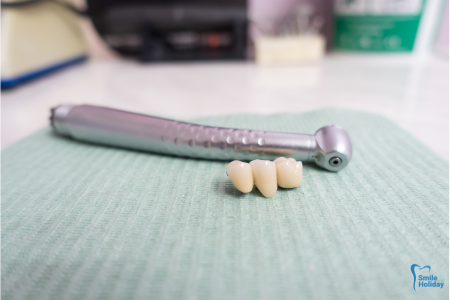Welcome to Smile and Holiday, your trusted dental clinic in the beautiful town of Fethiye! We understand the impact missing teeth can have on your confidence and oral health. That’s why we’re here to introduce you to an excellent solution that can restore both your smile and your ability to chew and speak comfortably: dental bridges.
At Smile and Holiday, we believe that everyone deserves a radiant smile that exudes self-assurance. Our dedicated team of dental professionals is committed to providing top-notch dental care, ensuring that our patients enjoy a positive and stress-free experience. We offer a range of restorative dental treatments, including dental bridges and implants, to help you regain the functionality and aesthetics of your natural teeth.
In this blog post, we will explore dental bridges, the pros and cons of dental bridges, the procedure involved, and why they are considered permanent and reliable solutions for missing teeth. So, if you’re seeking a long-lasting remedy for your tooth loss, keep reading to discover how dental bridges can transform your oral health and bring back your beautiful smile.
With our years of experience and expertise, we aim to educate and inform our readers about the various dental bridges available, empowering them to make informed decisions about their oral health. We understand that choosing the right dental treatment can be overwhelming, which is why we are here to guide you every step of the way.
Remember, at Smile and Holiday, we not only provide exceptional dental care but also offer the opportunity to experience the wonders of Fethiye. Combining your dental treatment with a rejuvenating holiday in this picturesque destination is a unique feature that sets us apart. Get ready to embark on a journey towards a confident smile and improved oral health!
What is a dental bridge?
A dental bridge is a restorative dental treatment designed to replace one or more missing teeth. It consists of one or more artificial teeth, known as pontics, anchored in place by dental crowns on the adjacent natural teeth or dental implants. The pontics effectively “bridge” the gap created by the missing teeth, restoring both the aesthetics and functionality of the patient’s smile.

Dental bridges are custom-made to match the colour, shape, and size of the natural teeth, ensuring a seamless and natural appearance. They are typically made from high-quality materials such as porcelain, ceramic, or a combination of metal and porcelain, providing strength, durability, and a lifelike appearance.
If you are considering dental bridges or have questions about restorative dental treatments, our team at Smile and Holiday is here to provide personalised guidance and exceptional care.
How does a dental bridge work?
A dental bridge works by bridging the gap created by one or more missing teeth. It consists of three main components: the pontics and the abutment teeth.
- Pontics: The pontics are artificial teeth that are custom-made to match the colour, shape, and size of your natural teeth. They fill the space left by the missing teeth and restore the appearance of a complete smile. Pontics can be made from materials such as porcelain, ceramic, or a combination of metal and porcelain, ensuring durability and a natural look.
- Abutment Teeth: The abutment teeth are the adjacent natural teeth on either side of the gap. These teeth provide support and stability for the dental bridge. In some cases, if only one adjacent tooth is available, a cantilever bridge may be used, where the pontic is supported by a single dental crown on one side.
- Dental Crowns: Dental crowns anchor the bridge to the abutment teeth. These crowns are placed over the existing natural teeth, which have been reshaped to accommodate them. The crowns serve as the anchor points for the bridge, holding it securely in place.
How many teeth can be in a bridge?
The number of teeth included in a dental bridge depends on the specific case and the patient’s needs. Dental bridges can be designed to replace one or more missing teeth.
The number of teeth that can be included in a bridge is determined by factors such as the adjacent teeth’ condition, the supporting tissues’ health, the patient’s oral health, and the desired outcome. During your consultation with a dental professional, they will evaluate your situation and recommend the most suitable type of bridge for your needs.
Here are the different types of dental bridges based on the number of teeth involved:
- Traditional Bridge: A traditional bridge is the most common type used to replace a single missing tooth or multiple consecutive missing teeth. It consists of a pontic (artificial tooth) that fills the gap and is supported by dental crowns placed on the adjacent natural teeth.
- Cantilever Bridge: A cantilever bridge is used when only one adjacent tooth is available to support the bridge. The pontic is supported by a single dental crown on one side of the gap.
- Maryland Bridge: A Maryland bridge, also known as a resin-bonded bridge or a Maryland-bonded bridge, is a conservative option to replace a single missing tooth. It involves using metal or porcelain wings bonded to the back of the adjacent natural teeth, with a pontic attached in between.
- Implant-Supported Bridge: In cases where multiple consecutive teeth are missing teeth or the adjacent teeth are not healthy enough to support a traditional bridge. This type of bridge is secured to dental implants surgically placed in the jawbone, providing excellent stability and support.
Which dental bridge is used for front teeth?
For replacing missing front teeth, the most commonly used dental bridge is a traditional bridge. The traditional bridge is a reliable option that provides a natural-looking result and restores the aesthetics of your smile.
The traditional bridge is supported by dental crowns placed on the adjacent natural teeth, which act as abutments. These crowns are designed to match the colour, shape, and size of your natural teeth, ensuring a seamless and cohesive look.
With a traditional bridge for front teeth, you can expect a natural and appealing result that blends seamlessly with your existing teeth. It restores the functionality of your bite, allows you to chew and speak with ease, and enhances your self-confidence.
What are the disadvantages of a dental bridge?
While dental bridges offer several benefits, it’s essential to consider their potential disadvantages. Here are some disadvantages of dental bridges:
- Alteration of adjacent teeth: To support the dental bridge, the adjacent natural teeth must be prepared by removing a portion of their enamel. Despite the low possibility, this alteration is irreversible and may compromise the integrity of otherwise healthy teeth.
- Increased risk of decay: Placing a dental bridge involves creating spaces between the pontic and the adjacent teeth, which can trap food particles and make proper oral hygiene more challenging. If oral hygiene is not maintained diligently, tooth decay and gum disease risk may increase.
- Potential for gum and bone loss: The absence of a natural tooth root can lead to the gradual deterioration of the underlying jawbone. Over time, this can result in gum recession and bone loss in the area where the tooth is missing.
- Limited lifespan: While dental bridges are designed to be durable, they are more subject to wear and tear over time than dental implants. The average lifespan of a dental bridge is typically around 10 to 15 years, after which it may need to be replaced or repaired.
- Limited suitability in certain cases: Dental bridges may not be suitable for everyone. For instance, if the adjacent teeth are weak, have extensive dental restorations, or are not optimal, alternative tooth replacement options such as dental implants may be recommended.
How long do dental bridges last?
The lifespan of a dental bridge can vary depending on several factors, including oral hygiene practices, the quality of the materials used, the location of the bridge in the mouth, and individual habits. On average, a well-maintained dental bridge can last between 10 to 15 years or even longer.
Is a dental bridge painful?
The placement of a dental bridge itself is not typically painful. The procedure is performed under local anaesthesia, ensuring you do not experience discomfort. Local anaesthesia numbs the area, so you should only feel pressure or slight sensations during the abutment teeth preparation and the bridge placement.

However, it is common to experience some mild soreness or sensitivity in the days following the placement of a dental bridge. This discomfort is usually temporary and can be managed with over-the-counter pain relievers, as your dentist recommends. It is essential to follow any post-operative instructions your dentist provides to ensure proper healing and minimise any potential discomfort.
How much does a dental bridge cost in the UK?
The cost of Dental bridges in the UK can vary depending on several factors, including the case’s complexity, the materials used, the dental practice’s location, and the dentist’s experience. Additionally, the number of missing teeth to be replaced and the need for additional procedures, such as dental crowns or implants, can also affect the overall cost.
The estimated dental bridge cost in the UK ranges from £500 to £1,500 per unit. Remember that this is a general price range, and the actual dental bridge cost UK may differ based on the abovementioned factors.
How much does a dental bridge cost in Turkey?
The cost of a dental bridge in Turkey can vary depending on factors such as the number of missing teeth, the materials used, the case’s complexity, and the dental clinic’s location.
On average, the cost of a dental bridge in Turkey ranges from 400$ to 700$ Turkish Lira per unit. However, it’s important to note that this is a general price range, and individual cases may vary.
During a consultation at Smile and Holiday, our experienced dentists will evaluate your specific needs, conduct a thorough examination, and provide you with a personalised treatment plan, including a detailed cost estimate. We are committed to transparency and will discuss all the associated fees and treatment options with you.

It’s worth mentioning that Turkey is known for its reputation as a popular dental tourism destination, offering high-quality dental treatments at more affordable prices compared to many other countries. However, choosing a reputable dental clinic like Smile and Holiday prioritises patient safety, uses quality materials, and has qualified dental professionals is important.
If you’re considering dental bridges in Turkey or have questions regarding the procedure, cost, or travel arrangements, our team at Smile and Holiday is here to assist you. We provide a seamless dental experience combined with the opportunity to enjoy the beautiful surroundings of Fethiye, making your dental treatment a part of your holiday experience.


